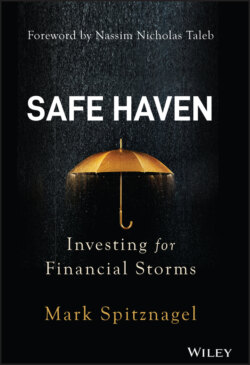Читать книгу Safe Haven - Mark Spitznagel - Страница 10
WHAT'S A SAFE HAVEN?
ОглавлениеEveryone has some intuitive understanding about what a safe haven is and why we would invest in one. Most likely, it would go something like “a place of refuge for when things go bad” or, more specifically, “an asset that provides safety from risk.” These are spot on. The term risk would likely mean scary things like stock market crashes, financial and banking crises, pandemics, monsters hiding under the bed, and so forth. Risk, then, is circularly defined as that equivocal thing we need safety from.
Plain and simple, risk is exposure to bad contingencies. Most of these bad contingencies will likely never happen, but they can happen. In investing, the bad contingencies have financial consequences of economic loss within a portfolio. Investment risk isn't just some theoretical and spurious numerical value, like volatility or correlation or whatever. It is the potential for loss, and the scope of that loss. Nothing else.
We have many diverging roads ahead, many potential paths forward with so many twists and turns, more than we can ever count. Some of those potential paths will be very pleasant, and some of those potential paths won't be. Of all the potential paths, we don't know which is the one and only path that we will actually traverse. Now, that's risk!
A safe haven is an investment that mitigates risk, or the bad potential economic contingencies in your investment portfolio. That is a necessary condition for safe haven status. It protects against consequential loss that happens to everyone, everywhere, all at the same time, because that loss is tied to the cycles of broad macroeconomic growth and contraction. Because of its ubiquitous and systematic nature, you can't just diversify that risk away with groupings of things that supposedly won't experience such loss simultaneously.
And remember this: A safe haven isn't so much a thing or an asset. It is a payoff, one that can take many different forms. It might be a chunk of metal, a stock selection criterion, a crypto‐currency, or even a derivatives portfolio. Whatever forms they may take, it is their function that makes safe havens what they are: They preserve and protect your capital. They are a shelter from financial storms.
So safe haven investing is risk mitigation. To me, these two terms are synonymous, and I will be using them interchangeably throughout this book. (The former made for a catchier title.)
What's more, risk mitigation is investing itself. Treat this as a fundamental premise. Even the most renowned proponent of the bottom‐up approach to investing, Benjamin Graham, the “father of value investing,” declared: “The essence of investment management is the management of risks, not the management of returns. Well‐managed portfolios start with this precept.” Moreover, “Confronted with a challenge to distil the secret of sound investment into three words, we venture the motto, Margin of Safety.” Truer words have never been written on the subject. For Graham, “safety of principal” is what separates investing from speculating. It makes investing—investing! (He learned the hard way, in the 1929 stock market crash, that all great ideas can be dashed, simultaneously and systematically.)
But this is the pretty obvious part. It still misses what's so special about what a safe haven should be. Any punter can devise something that does well in a financial crash. Safe haven investing is so much more. And this is where they start to look really different from each other—so different that our classification that would put them all in the same category starts to lose its meaning. Often, they are more different than they are alike. We run into issues similar to what biologists encountered when trying to define what a species is. We will need a specific safe haven concept—like their species concept—in order to classify them and evaluate if they are even what they claim to be. This will be a major line of inquiry in this book: Are safe havens a classifiable thing? And can they really add economic value?
